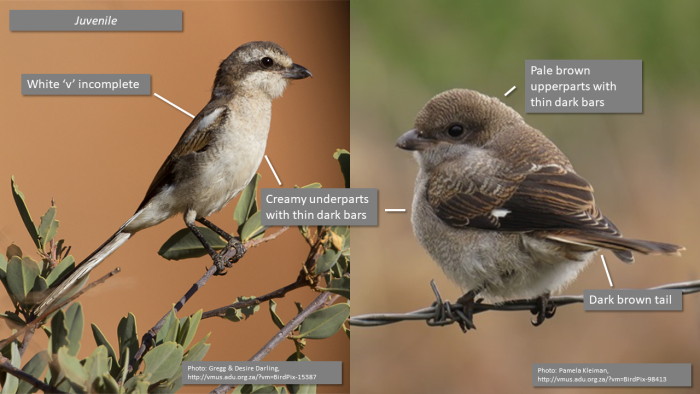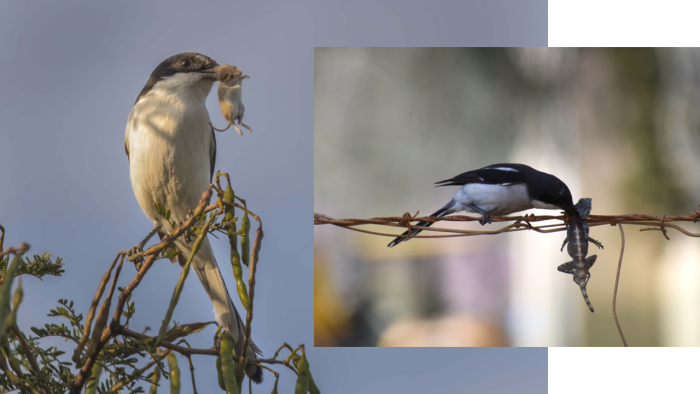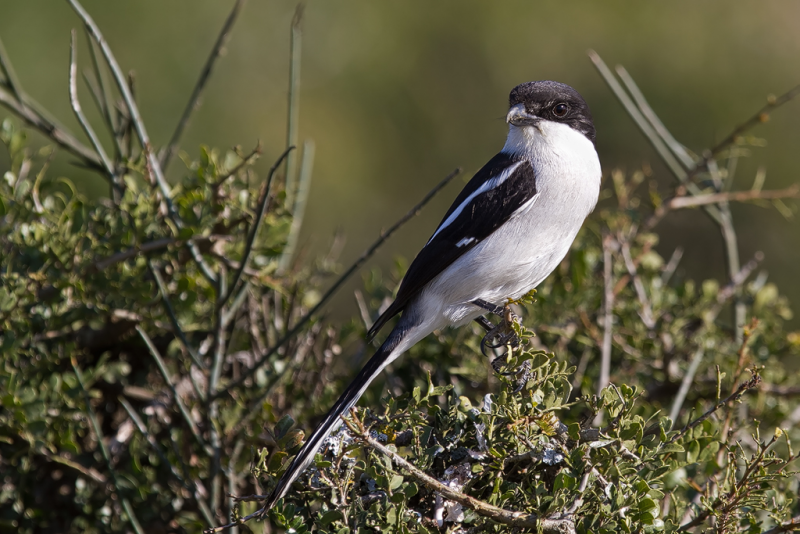Cover photo: Southern Fiscal BirdPix 8316 – Desire Darling
Identification
The Southern Fiscal can be identified by its distinct black and white colouration and its strongly hook-shaped bill. It has a black bill, face, and legs. It has a characteristic white “V” on its back and a relatively long black tail with white outer feathers. Adult male and female Southern Fiscals are quite similar apart from the rufous/chestnut patch of feathers the female has on her sides. The Fiscal Flycatcher has a similar black and white pattern, but it has a thinner and pointed bill.

The north-western subspecies of the Southern Fiscal has a distinct white eyebrow as shown in the photos below.

Their call is a jumbled mix of shrike-like swizzling sounds including some imitations. Also a harsh “Dzzzttt-dzzzt-dzzzt” alarm call.
Juveniles have pale brown upperparts and creamy underparts with thin dark barring.

Habitat
It occupies a wide variety of habitats but generally prefers open habitats with scattered trees, such as savanna, open woodland, shrubland and grassland. It is also very common in human-altered habitats like gardens, parks, farmland, and roadsides. They love places with good perches from where they can scan for potential prey.

Distribution
Widespread across sub-Saharan Africa, but absent from much of the Democratic Republic of Congo, Somalia and Ethiopia. In southern Africa it occurs almost everywhere in South Africa, extending into much of Namibia, Zimbabwe and southern Botswana. The Southern African Bird Atlas Project (SABAP2) data on the Southern Fiscal are displayed in the map below. The blue and green squares (i.e., pentads) are the core of its range in South Africa, Lesotho and eSwatini. These are the pentads where their reporting rate is highest.

Behaviour
The Southern Fiscal is usually solitary and hunts insects and small rodents from an exposed perch and can often be seen at the tops of shrubs or small trees. They have a habit of impaling their prey on thorn tree thorns or fences so as to store the prey items for later consumption. This is why they are also known as Jackie Hangman or the Butcher Bird.

Further resources
Species text from the first Southern African Bird Atlas Project (SABAP1), 1997.
Virtual Museum (BirdPix > Search VM > By Scientific or Common Name).
More common names: Fiskaallaksman (Afrikaans); Inxanxadi (Xhosa); iLunga (Zulu); Pie-grièche Fiscale (French); Fiskalwürger (German); Gekraagde Klauwier (Dutch).
Recommended citation format: Loftie-Eaton M and Daniel KA 2022. Southern Fiscal Lanius collaris. Bird Feeder Project. Biodiversity and Development Institute. Available Online at http://thebdi.org/2022/06/01/southern-fiscal-lanius-collaris/

